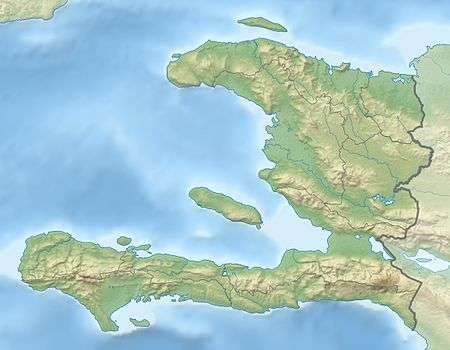Battle of Vertières
The Battle of Vertières (in Haitian Creole Batay Vètyè) was the last major battle of the Haitian Revolution, and the final part of the Haitian Revolution under Jean Jacques Dessalines. It was fought on 18 November 1803 between Haitian indigenous army, and Napoleon's French expeditionary forces, who were openly committed to re-enslave the former enslaved people and regain control of the island.
| Battle of Vertières | |||||||
|---|---|---|---|---|---|---|---|
| Part of the Haitian Revolution | |||||||
| |||||||
| Belligerents | |||||||
|
|
| ||||||
| Commanders and leaders | |||||||
|
|
| ||||||
| Strength | |||||||
| 2,000 men | 27,000 men[1] | ||||||
| Casualties and losses | |||||||
| 1,200 dead and wounded |
1,200 dead 2,000 wounded | ||||||
 Location within Haiti | |||||||
Vertières is situated just south of Cap-Haïtien (known then as Cap-Français), in the Départment du Nord, Haiti. By the end of October 1803, the forces fighting the expeditionary troops had already taken over most of the territory of St. Domingue. The only places controlled by the French forces were Môle St. Nicolas, held by Noailles, and Cap-Français, where, with 5,000 troops, French General Rochambeau was at bay.
Defeat of the French Army by the Haitian Army
In 1802, the revolutionary leader Toussaint Louverture was captured by Napoleon's troops. From the ship that would lead him to his prison cell, and eventual death, Louverture said: “In overthrowing me, you have done no more than cut down the trunk of the tree of black liberty in St. Domingue. It will spring back from the roots, for they are numerous and deep.”[2] After L'Ouverture’s death, Jean Jacques Dessalines continued the fight for liberty by leading the resistance to the French.[3]
Dessalines defeated the French army numerous times before the battle of Vertières. During the night of 17–18 November 1803, the Haitians positioned their few guns to blast Fort Bréda, located on the habitation where Louverture had worked as a coachman under François Capois. As the French trumpets sounded the alarm, Clervaux, a Haitian rebel, fired the first shot. Capois, mounted on a great horse, led his Haitian demi-brigade forward despite storms of bullets from the forts on his left. The approach to Charrier ran up a long ravine under the guns of Vertières. French fire killed a number of soldiers in the Haitian columns, but the soldiers closed ranks and clambered past their dead, singing. Capois' horse was shot, faltered and fell, tossing Capois off his saddle. Capois picked himself up, drew his sword; brandished it over his head and ran onwards shouting: "Forward! Forward!" (En avant! En avant!). Mesmerized by his valiant courage, the French soldiers temporarily ceased fire as they all applauded Capois.
Rochambeau was watching from the rampart of Vertières. As Capois charged forth, the French drums rolled a sudden cease-fire. Suddenly, the battle stopped. A French staff officer mounted his horse and rode toward the intrepid Capois-la-Mort (Capois-the-Death). With a loud voice, he shouted: "General Rochambeau sends compliments to the general who has just covered himself with such glory!" Then he saluted the Haitian warriors, returned to his position, and the fighting resumed.
General Dessalines sent his reserves under Gabart, the youngest of the generals, while Jean-Philippe Daut, Rochambeau’s guard of grenadiers, formed for a final charge. But Gabart, Capois, and Clervaux, the last fighting with a French musket in hand and with one epaulette shot away, repulsed the desperate counterattack.
A sudden downpour with thunder and lightning drenched the battlefield. Under cover of the storm, Rochambeau pulled back from Vertières, knowing he was defeated and that Saint-Domingue was lost from France.
Results of the Battle
By the next morning, the general Rochambeau sent Duveyrier to negotiate with Dessalines. At the end of the day, the terms of the French surrender were settled. Rochambeau got ten days to embark the remainder of his army and leave Saint-Domingue. The wounded French soldiers were left behind under lock and key until they could be returned to France, but they were drowned a few days later.[4] This battle occurred less than two months before Dessalines' proclamation of the independent Republic of Haiti on 1 January 1804. November 18 has been widely celebrated since then as a Day of Victory in Haiti.
References
- Jacques de Cauna, Haïti, l'éternelle révolution: histoire de sa décolonisation (1789-1804), p.177.
- Granqvist, Manne (2006). "Haiti: the deep roots of liberty". New African. April 2006 (450): 50. ISSN 0142-9345.
- Accilien, Cécile (March 2015). Revolutionary Freedoms: A History of Survival, Strength and Imagination in Haiti.
- Jeremy D. Popkin (2012). A Concise History of the Haitian Revolution. Chichester, West Sussex: Wiley-Blackwell. ISBN 978-1-4051-9820-2. Page 137.
External links
- A Great moment in Haitian History:
- The Louverture Project: The Battle of Vertières
- The Louverture Project: French Capitulation in Saint-Domingue